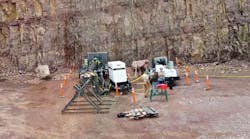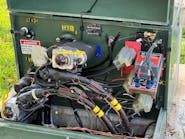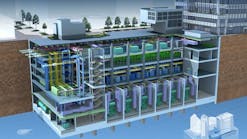Petra Unveils the First Tunneling Technology for Utilities to Bore Through the Hardest Rocks in the World
Petra, the first robotics company capable of undergrounding critical utilities through hard geologies, today announced the successful completion of a 20-foot demonstration tunnel through the hardest rock on earth, and Series A funding led by DCVC, the leading Deep Tech venture firm. Petra has invented a new hard rock boring-robot, transforming the way all utilities are buried underground by tackling the hardest problem in underground construction: how to bore utility tunnels reliably and cost-effectively through nightmare geologies. The ability to underground utilities is essential to meet the increasing global demand for energy, and to avoid grid-related disasters in the face of violent climate change.
“In the past, there have only been a handful of costly and inefficient methods for tunnel construction, starting with manual tools and evolving to the modern tunnel-boring machine. Our non-contact method is the next evolution of tunneling and will usher in a new age of undergrounding utilities,” said Petra CEO and co-founder Kim Abrams. “By delivering the first non-contact, boring-robot that affordably undergrounds utilities through bedrock, we can protect communities around the world from exposure to wildfires and ensure the safety of critical infrastructure in disaster-prone areas.”
Petra has developed the first non-contact, thermal-drilling method that can uniquely bore 60-inch diameter micro tunnels through hard rock, making it possible to bore utility tunnels through previously impenetrable geologies. Conventional micro-tunneling machines are purpose-built for a single diameter. By contrast, Petra is capable of boring a range of diameters between 20-60 inches, dramatically reducing the costs of tunneling. Petra also offers the first reverse-tunneling technology, making machine maintenance and cutter head rescue possible. Petra is enabling customers to rapidly bury critical utilities for a fraction of the cost of legacy techniques, which includes construction services, tunnel development, and ongoing maintenance.
“At DCVC we’re committed to investing in companies that are building solutions to make our society’s infrastructure more resilient. Petra’s ability to bore tunnels in bedrock is transformational for global utilities and innumerable other applications,” said Dr. Chris Boshuizen, DCVC Partner and co-founder of Planet. “Petra’s tunneling technology is providing a safer, faster, and more cost-effective option for all underground infrastructure - electricity, water, sewage, and enables projects the world would never have been able to do before.”
“As the former President of SoCal Edison, I oversaw capital projects in urban, suburban, and rural mountainous areas. A robot that can bury utility facilities in bedrock would have been a game-changer for us,” said Bob Foster, a Petra Advisor. “In cities, it would allow us to bury utilities in bedrock, below the existing infrastructure. In mountainous areas, like the Sierra foothills, it would allow us to bury utilities in the most fire-prone regions of our state.”
Petra’s semi-autonomous robot can tunnel faster and cheaper than conventional undergrounding methods, and through geologies previously thought impenetrable. By contrast, traditional micro Tunnel Boring Machines (mTBM), Horizontal Directional Drilling (HDD), and other conventional “trenchless” methods have cutter heads which easily break when drilling through hard rock, increasing project cost and complexity.
“Petra successfully completed a 20-foot bore through hard Sioux Quartzite, where we averaged an astounding one-inch-per-minute in a geology usually excavated by dynamite,” said Ian Wright, Petra’s CTO and a Tesla co-founder. “No undergrounding method has been able to tunnel through this kind of bedrock until now. This achievement is due to Petra’s thermal drilling method which efficiently bores through rock without touching it.”
The US national grid, established more than 40 years ago, wasn't built to withstand climate change or new strains on the system. Above-ground power lines have caused thousands of wildfires in recent years and are frequently destroyed during violent storms. Without a new approach, the stresses will only get worse. The Energy Information Administration (EIA) projects global energy demand will increase by 50% in the next 30 years, requiring more transmission lines — if we want a resilient infrastructure, power lines must be undergrounded.
In addition, Petra addresses vulnerabilities in cities to prevent man-made disasters like the San Bruno pipeline explosion of 2019. Most cities have a maze of existing utility infrastructure that lives in the soft soil layers, just below the surface. Going into bedrock below the existing infrastructure allows engineers to reduce the complexity and vulnerabilities of urban utility projects. Petra was founded by CEO Kim Abrams and CPO Shivani Torres, and has raised a total of US$33M in funding from DCVC, ACME Capital, Congruent Ventures, 8VC, Real Ventures, Elementum Ventures, and Mac Venture Capital.


